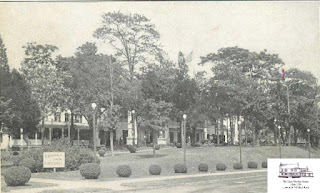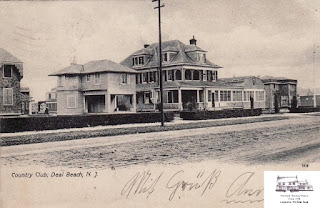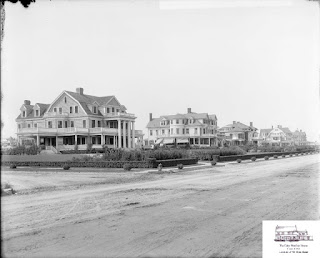Deal Former Sections
Digital interactions for Friends of the
Township of Ocean Historical Museum!
FORMER SECTIONS OF THE TOWNSHIP OF OCEAN
The entire coastal area of Monmouth County, from Deal Lake to Takanassee Lake and as far west as Oakhurst, was once all known as Deal. It was named after the home of Thomas Whyte, one of the original English settlers of this area, who was from Deal, County of Kent, England. The area that is today the Borough of Deal was originally known as Darlington from 1894 to 1897. The area broke away from the Township of Ocean in 1898.
The Borough of Deal (or Darlington as it was known at the time) originally was only the area that today consists of Roseld Avenue to the north and Neptune Avenue in the south, as shown on this 1897 map of the Borough.
The first Deal train station (called Darlington) was built in 1894 on the west end of Deal Esplanade. (the beach club at the east end) The building was moved in 1902 to make way for a new station. The building was sold to Deal Golf and Country Club, where it became the men's locker room.
The second Deal train station was built in 1902. Train service ended to Deal in 1955. The abandoned station burned down in 1958.
The Borough also had water sprinkler trucks that were used before paved roads to keep down dust from the roads. They also served as fire tankers when necessary.
The Allenhurst Livery, also know as Buckelewe & McCue's Livery was in existence prior to the development of Allenhurst. It was located on Main Street close to the Deal border on Neptune Avenue. The livery provided boarding for horses as well as carriage maintenance, After 1925, it was used as a garage, until a fire in 1940. It was torn down shortly thereafter. The Allenhurst post office was built on the site in 1958.
The first Deal Borough Hall was a small structure that housed the Borough office, police department, and a jail.
The second Borough Hall was built in 1924 on property that was donated by William C. and Catherine Durant. The building has been expanded over the years but continues to house the municipal offices and police departments.
A. Matovsky's Nursery used to stand on Norwood Avenue, where the Synagogue of Deal stands today.
Most people don't realize it, but the amount of the Deal business district that is actually in Deal is quite small. A large section of the business district is actually in Ocean Township.
Deal Conservatoire, Deal Esplanade - Built in 1903 as the home of Arthur Horgan, this Stanford White-designed building served as a nightclub (Braxton Club) in the 1920s and early 30s. From1933 to1949, it was the Deal Conservatoire- a center of performing arts offering live theater and performance classes. The building was razed in 1955.
In 1854, William Hathaway purchased the farm and hotel of Thomas Borden. The hotel was conveniently located on Deal Turnpike (now Norwood Avenue) between Sydney and Hathaway Avenues. In 1897, it was the scene of a gala lawn party celebrating the incorporation of the Borough of Deal. It was torn down in 1933.
The Deal Inn was located at 29 Richmond Avenue. Built-in 1880, it was originally known as the Deal Country Club (no relation to the Deal Golf and Country Club) and later was known as the Country Club Cafe, then the Deal Inn. It closed in 1933 and was destroyed by fire in October 1940.
The Roseld Inn was originally on Roseld Avenue, just west of Borough Hall, where Roseld Court is today. At the time, the Roseld Inn accepted overflow from the Hathaway Inn. In about 1919, the inn was moved to the southwest corner of Neptune Avenue and Richmond Avenue, where it exists today as apartments.
The Hotel Bainwright, located at 51 Hathaway Avenue, was the last of the hotels in existence in Deal. It was strictly a summer establishment. It was destroyed by fire in 1960.
Deal Esplanade originally ran from the Deal Train Station (no longer there) to the Atlantic Ocean with the Old Deal Casino just off to the side (also gone). The Esplanade still wanders down to the sea, but today it is all residential properties.
The Deal Golf club was originally a private golf course for George W. Young, best known today as the 3rd husband of opera star Madam Lillian Nordica. In 1898, it was incorporated as Deal Golf Club. Interestingly, while the Club House, driveway, and practice areas are in Deal, the vast majority of the club is in the Township of Ocean.
Kildysart, the O'Day-Ahnalt Mansion was located west of the railroad, between the railroad and Deal Lake. The entrance was over what today is the footbridge over the railroad at the end of Sydney Avenue. Daniel O'Day, who built the mansion was one of the original shareholders of Standard Oil. It was purchased in 1914 by William P. Ahnelt, who changed the name to Ahnelt Hall. The house was destroyed by a fire in June 1935. The Deal Harbour Estates exist there now.
This is the Henry Goldman Estate. Goldman was one of the founders of Goldman Sachs. Goldman broke with his brother-in-law and main partner Samuel Sachs and the bank during World War I. In 1915, as tensions rose in Europe, Goldman publicly voiced support for the Germans and refused to allow Goldman Sachs to participate in a $150 million Anglo-French bond issue arranged by J. P. Morgan.[6] The rest of Goldman's colleagues supported the Allies. In 1917, after America entered the war, Goldman resigned as a partner from Goldman Sachs in recognition of the negative effects of this irreconcilable difference of opinion.
Isidor and Ida Straus' estate was located on Ocean Avenue in the north end of Deal. Mr. Straus was President of the R.H. Macy Company. The tragically died in the sinking of the RMS Titanic in 1912. The house existed until 1961 when it was torn down to make way for Clem Conover Road.
Shorelands, the Estate of Henry Seligman, was located on Ocean Avenue, adjacent to the estate of his cousin Jefferson Seligman. The eight Seligman brothers who founded the investment firm of J. & W. Seligman & Co. had 36 sons (of which Jefferson and Henry were two), all of whom worked for the firm. The house featured a third-floor lanai from which you could view the ocean.
In 1906, Edward V. Hartford, heir to the A&P fortune, commissioned the architectural firm of McKim, Mead & White to design his home at 217 Ocean Avenue. The Italian-style villa was located on 3 acres and featured 20 rooms and a 5 car garage. Hartford dabbled with inventions related to automobiles and is credited with inventing and patenting the Hartford Shock Absorber. The home still exists today but has been altered extensively.
Mayor Frank "Boss" Hague of Jersey City, was famous for the quote "I am the law." His estate in Deal was quite impressive, especially when one considers at the time Mayor of Jersey City was a part-time job (and his only job). When he was later asked by investigators how he could afford such a magnificent estate on his small salary, his response was, "thrift."
"The Corners" was the home of railroad magnate Newman Erb, and was built in 1903. It covered the entire area from Roosevelt and Ocean Avenues to Norwood Avenue and as far south as Poplar Brook. Mr. Erb's estate was well known for its beautiful vista, immaculate landscaping, and exotic gardens. The home was designed by architect Clarence W. Luce.
Raymere, originally designed for Jacob and Regina Rothschild, was built in 1908 on the corner of Runyan and Ocean Avenues. William C. Durant, the founder of General Motors, purchased the estate in 1920 and lived there until 1940. In September 1951, the Arnold Wrecking Company began the seven-week project to level the mansion.
"Sunny Haven" was the home of Leo Sonneborn, a New York embroidery company owner. The 27 room mansion was on Ocean Avenue, near Roseld, and was between the Durant and White estates. It was designed in the Mediterranian Villa-style by H.A. Jacobs and built by I.R. Taylor Building Company of Asbury Park.
Mrs. Charles Kaye named her Greek Revival-styled home Arcadia. It was located on the northwest corner of Brighton Avenue and Ocean Avenue. Built in 1907, it had sweeping views across Ocean Avenue to the sea. The Deal Casino was moved down Ocean Avenue and across from Arcadia in 1957. The house was razed in 1987, following a public auction to dispose of interior elements.
"Brookside," the home of J.C. Lee, president of the Monmouth Shirt Company, was located on the northwest corner of Poplar and Ocean Avenues.
The home of investment banker Arthur Lipper, located on the southwest corner of Brighton and Ocean Avenues, was known as "Claranden."
The landmark Tudor chalet located on Sydney and Ocean Avenues was designed by its owner, G.K. Thompson in 1897. Thompson also designed several buildings in New York, including the Standard Oil Building, the Manhattan Life Building, and the B. Altman & Co. Department Store Building. He also designed the Daniel O'Day house, "Kildysart," which looks amazingly similar. Unfortunately, the house was severely damaged by fire in 1997 and was razed later that year.
Gustav M. Miller owned boys and children's clothing company, G.M. Miller & Co. He also owned this home on the southwest corner of Roseld and Ocean Avenues.
The cheerful waitresses gather outdoors on the steps of the Darlington Inn for this informal portrait in 1900. (From "Those Innocent Years; 1898-1914 - Images of the Jersey Shore from the Pach Photographic Collection", by George H. Moss and Karen L. Schnitzspan)
Indian clubs, dumbells, boxing gloves, a bicycle, and beer are indicative of the varied interests of the Darlington Sporting Club members at Deal in 1900. (From "Those Innocent Years; 1898-1914 - Images of the Jersey Shore from the Pach Photographic Collection", by George H. Moss and Karen L. Schnitzspan)

























































































































































